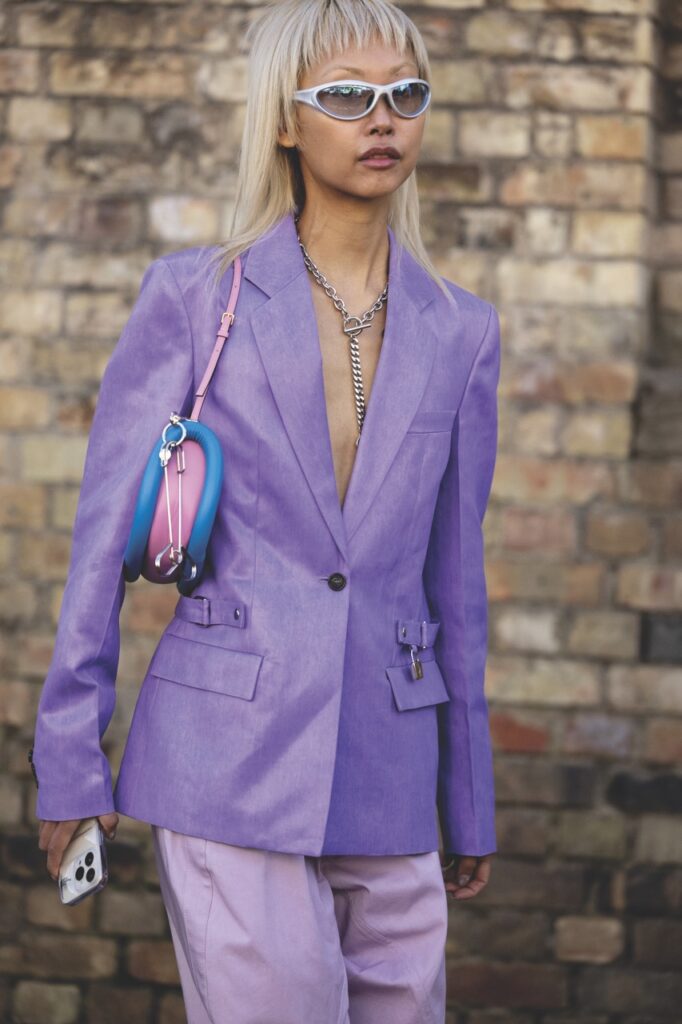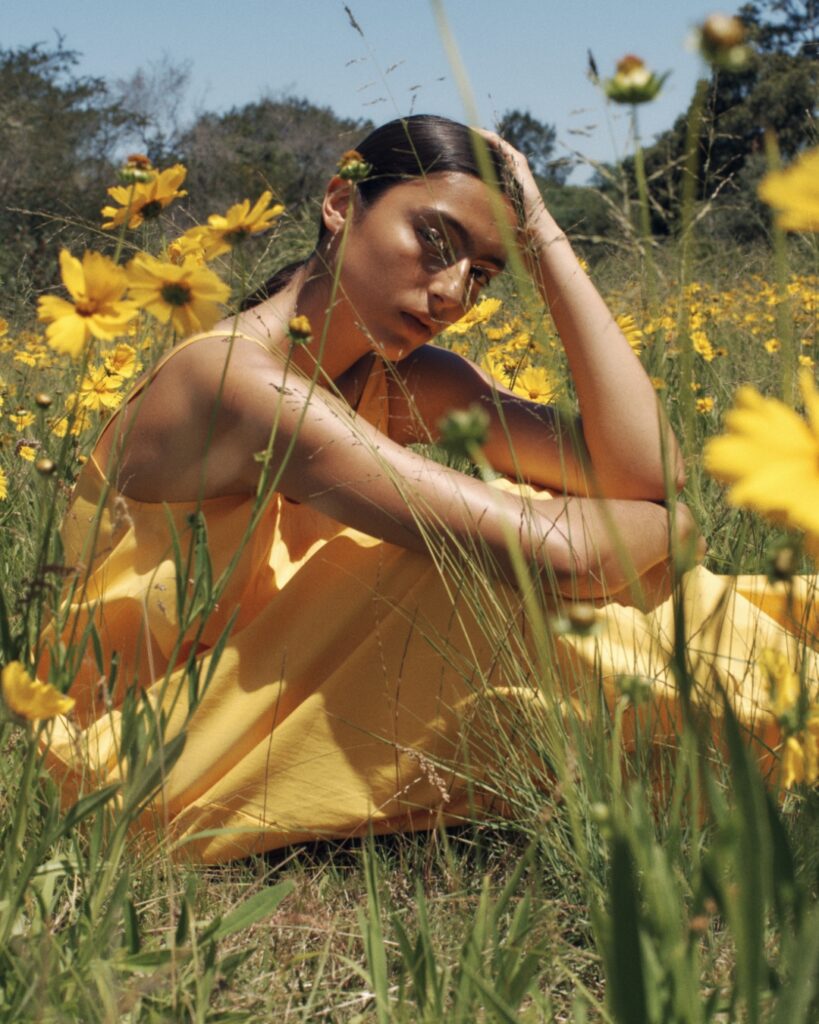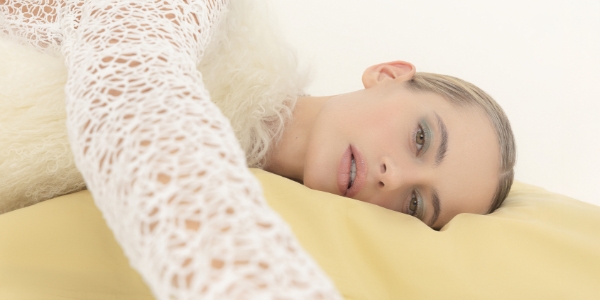
A big bow in your hair, a peplum-shaped shirt and a ruffled, tiered skirt — add to that a silver chrome handbag and a pair of pointed, heeled boots. Although it reads like a ridiculous combination of clothing, these styling notes were recommended to me in a single TikTok video, captioned as microtrends that will take off in 2023.
From ballet- and Barbie- to chrome- and even clown-core, the trends we see today are a little silly — and, more seriously, the fracturing of all these looks can split our sense of self. Although trends have always been part of the human experience — it’s only natural to want to #t in with the (fashion) pack — their current speed has given us wardrobe whiplash, especially if we try them all on at once.
Trends were initially identified by historians, who could look back and pinpoint the romanticism of the early 1800s Regency era, with all its poetry and pearl necklaces. As society became more introspective, sociologists and culture-watchers turned their attention to contemporary trends, like the swinging short skirts of the ’60s and the swaying hippie attire of the ’70s.
Behavioural psychologist, business consultant and author of The Psychology of Fashion, Dr Carolyn Mair, calls on professor Everett Rogers’ Diffusion of Innovations Model (first published in 1962) to describe the cycle of trends. “Innovators start the trend, which is then picked up by early adopters, early majority, late majority and the laggards who might never actually adopt it at all.”
In the 20th century, trends were often defined and distributed through mass media (and the celebrity trendsetters it showcased), then the age of the internet brought new sources of inspiration and information: street style, runways, social media and blogging. It’s given us endless creative niches — if we’re careful. “Decades ago, you weren’t fashionable if you weren’t wearing the dominant trend (e.g. in the ’60s miniskirts, bell-bottom jeans, shrunken jumpers), but now, anyone can look fashionable if they have the confidence to carry o” their total look,” writes Dr Mair.
Social commentators have, ironically, declared a post-trend narrative for several years, but something feels different about this cycle. “It’s rare to have one trend dominate in fashion these days,” Dr Mair continues. “Consumers are told this or that is trending in multiple outlets and on social media, yet these vary according to sponsorship and target audience, and are adopted according to individual consumer preferences.”
TikTok in particular has created an endless feedback loop, where there are just as many new trend reports and advice videos as there are ways of wearing any given trend. It’s novelty in the name of nomenclature — just add ‘core’ at the end. We have countless cultural references only a click away, but they often leave behind context. That’s why for those who experienced the early aughts, Y2K style can feel like cosplay, unless it’s incorporated into a broader sense of self.
A fashion-core can still strike a resounding cord with some people, a fact demonstrated throughout history. In the 18th century, Marie Antoinette dabbled with cottage-core among the dappled leaves of the Petit Trianon and dressed up in shepherdess dress. During the late 1700s’ Directoire period, fashionable French female aristocrats known as the Merveilleuses draped themselves in Neoclassical-style dresses that recalled figures of classical antiquity. Mythic-core, if you will.
Modern societies have always wanted to assign labels, and like many human quirks, social media has only intensified this. Algorithms tend to group together content that’s similar, so it makes sense that once you like a post about Regency-core, you start seeing modern day renditions of empire-line dresses and even elbow-length gloves all over your app. On one hand, it’s a fun way to learn more about fashion — on another, it’s ramping up already rampant consumerism. Add to this an interest in It-products (designer handbags, hyped sneakers…) and such searches seem to become about status rather than satisfaction.


As trend-watchers already know, star trends that are adopted at speed often shine brightly but burn out quickly. Take Mschf’s Big Red Boots, which look too cartoonish to wear but for that very reason became the clickbait clothing on the New York Fashion Week streets. They made for an interesting social commentary, but like many celebrity looks, these boots aren’t made for walking in for long.
“Social media tells us this or that is the new trend because a celebrity was seen wearing it, but that celebrity is likely to be snapped wearing something entirely different in another shot on the same day,” says Dr Mair.
We have very visual references for the speeding up of trends today, like ’90s babies dressing as, well, ’90s babies, and the early adoption of early-2000s McBling style. However, as with most cycles, the interpretation of this is not straightforward. “In a sense, trends last a shorter time now, but that may be because no single trend becomes the dominant one,” reiterates Dr Mair.
“Fashion now is more about a total look than about following a particular trend.” As so many trends whizz around, how do we find a timeless sense of personal style? Alarmingly, it’s lovers of fashion who are most likely to become its victims. “Someone who follows fashion trends may not establish their own personal sense of style; whereas a stylish person dresses for their own identity and sense of self rather than simply following fashion trends,” says Dr Mair.
From linen-loving ‘coastal grandmas’ to scene-stealing ‘rom-com dressing’, certain fashion tropes currently have a hold on the industry’s imagination, but why concentrate on these characters when you can focus on your own?
One of the biggest stories to come out of New York Fashion Week (on the runway this time) was that designers are making clothes for the real world again. Proenza Schouler designers Jack McCollough and Lazaro Hernandez called their strong, wearable collection, including blazers and knit dresses, “just clothes”.
At Tory Burch, an “undone attitude” was included in the show notes, as slouchy sweaters and relaxed trench coats gained all the right attention. Despite their demure descriptions, the clothes were a revelation for many in the front row — they required you to stop snapping and lean closer to appreciate their craftsmanship.
Online, the fervour around ‘old Celine’ designer Phoebe Philo starting her own label of intelligent fashion only furthers this calling for quiet luxury. At the time of writing, her eponymous label has 176,000 Instagram followers, despite not launching until September.
“There’s so much noise now in terms of brands and trends and influence, so it makes sense that with this action there will be a subsequent reaction,” says Lauren Tapper of New Zealand label Harris Tapper, which is known for its understated sophistication.

“Although we make clothing that sits in line with a traditional calendar, we want every single product we release to be perfect and carry the same thought and intelligence that the women who wear our clothes embody.” Rarefied personal style can sometimes take on mystic proportions, or the old-school style notion of you either have it or you don’t. (It’s worth noting that personal style has been searched as a hashtag on TikTok 567 million times and counting.)
Wynn Crawshaw of Wynn Hamlyn, who offers redefined designs with a sometimes eccentric elegance, has a different take. He suggests finding your personal style through repeated experiments, both successful and complete disasters. “When you don’t quite know what your style is, then you must first be open to finding out what it’s not,” he says. “Personal style is about self-expression, and by eliminating the things that don’t resonate with you, you can get to the core of who you are. It’s a tension between feeling comfortable and pushing yourself to step outside your comfort zone.”
As a label with a strong community in New Zealand and a growing following in opposite seasons overseas, versatility is essential to Wynn Hamlyn designs that can go anywhere with you. “I think we must stay mindful of longevity whenever we design or buy pieces, choosing in favour of something that will last,” says Crawshaw.
A checklist of specific items and looks can leave your wardrobe feeling empty if there isn’t a deeper connection with them. Designer of fun yet intelligent label Loclaire, Frances Lowe, looks to create a story with each of her collections. “I’ve noticed over time and through experience that our visual language is always stronger and better received when there’s a sense of storytelling behind it,” she says. “I love to design pieces that create an emotional connection with the wearer, whether it be through visual cues, pieces you can wear multiple ways, or an interesting fabric or texture that evokes certain feelings. In the bigger picture, this emotional connection is really important; if we feel a sense of joy and pride in our clothes, we’ll ultimately wear and care for them with a lot more attention.”


Having a greater appreciation of our clothing choices can translate to a greater appreciation for our planet. “I think that the essence of trends is a healthy and natural part of any life cycle, but creating and consuming trends through the lens of today’s social media has become really unhealthy in so many ways,” says Lowe. “Nothing exists in a vacuum and trends have become inextricably linked with serious issues such as youth mental health, global inequalities and injustice, and climate change.”
Fast fashion thrives off micro-trends, yet there are still ways to find exciting wardrobe additions through slow fashion. Although Loclaire’s designs, including its daisy and heart cut-outs, may be very Instagram-worthy, they’re made to order and be appreciated beyond the initial digital dopamine hit. In this way, a longer-term luxury can feel even more indulgent. It’s a broader behavioural trend, but hopefully one that has staying power. “We actually celebrate and encourage the time taken to make a single garment,” says Lowe. “Once our designs are released, as long as our community keeps wanting them, they’re there for the long haul, offered month after month, year after year.”
Of course, your personal style will develop as you do. For Lowe, this process began in adolescence, with a punk-rock era and an obsession with Green Day. Now she’s actively working on learning more about her heritage and naturally drawn to design details that give a nod to traditional Chinese or Asian craft. “I think this is a nice way to approach personal style, as regardless of current trends, the starting point is a set of values or ideas that are unique to you,” she says.
Appreciating creativity in all its forms will lead to a deeper engagement in your wardrobe, no matter how distinctive your style. “It’s less of a destination and more a journey that evolves as you mature and grow,” says Tapper of her and co-founder Sarah Harris Gould’s sense of style. “We know when we’re both dying to wear [a design] straight away, even if it’s a floor-length coat in the middle of summer. In a fitting, when a piece is right, there’s an emotional connection we feel — something about the proportions or fabric or detailing in that piece once it’s complete that triggers a physiological response and lets us know in our gut it’s right.” As it turns out, the only fashion-core we need is the core self.










